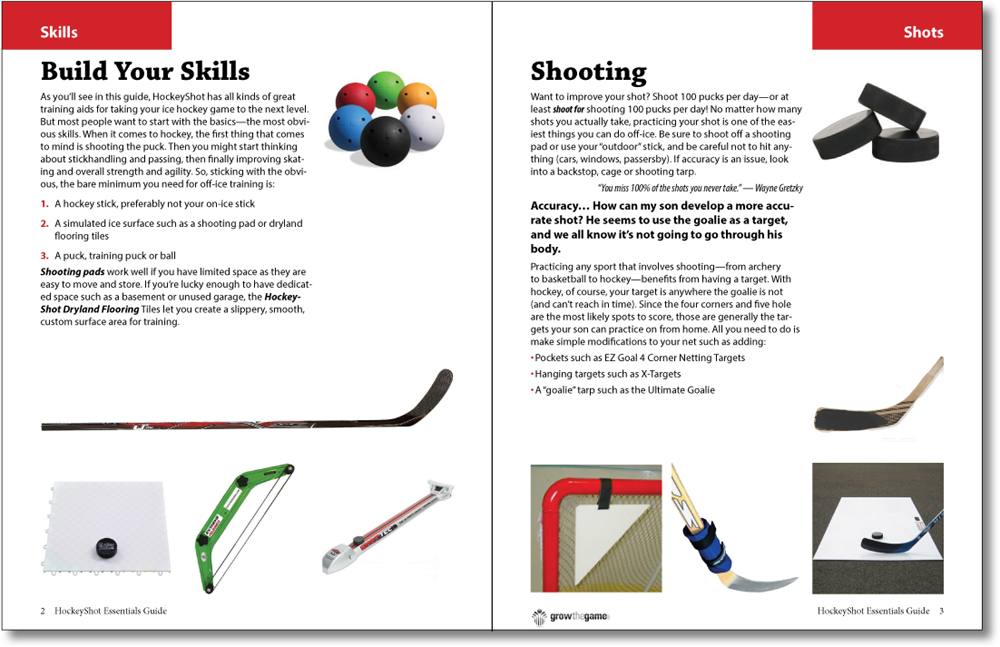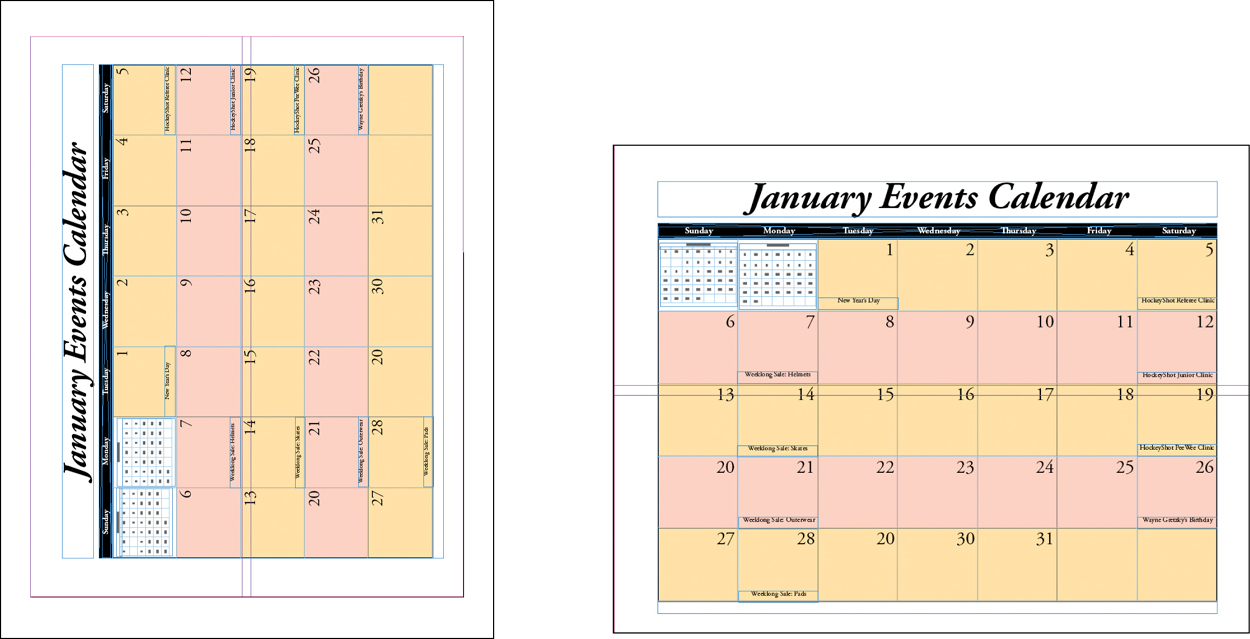3. Setting Up a Document and Working with Pages
Lesson Overview
In this lesson, you’ll learn how to do the following:
• Save custom document settings as a document preset.
• Start a new document and set document defaults.
• Lay out a master page.
• Create an additional master page.
• Apply a master page to document pages.
• Add pages to a document.
• Rearrange and delete pages.
• Change the size of pages.
• Create section markers and specify page numbering.
• Lay out document pages.
• Rotate a document page.
This lesson will take approximately 90 minutes.
Download the project files for this lesson from the Lesson & Update Files tab on your Account page at www.peachpit.com and store them on your computer in a convenient location, as described in the Getting Started section of this book.
Your Accounts page is also where you’ll find any updates to the chapters or to the lesson files. Look on the Lesson & Update Files tab to access the most current content.
By taking advantage of the features that help you set up the documents you create, you can ensure consistent page layout and simplify your work. In this lesson, you’ll learn how to specify settings for a new document, design master pages, and work with document pages.
Getting started
In this lesson, you’ll set up an eight-page newsletter, and then place text and graphics on one of the document’s facing-page spreads. You’ll also create a smaller insert within the newsletter that uses a different page size.
![]() Note
Note
If you have not already downloaded the project files for this lesson to your computer from your Account page, make sure to do so now. See “Getting Started” at the beginning of the book.
1. To ensure that the preference and default settings of your Adobe InDesign program match those used in this lesson, move the InDesign Defaults file to a different folder following the procedure in “Saving and restoring the InDesign Defaults file” on page 3.
2. Start Adobe InDesign. To ensure that the panels and menu commands match those used in this lesson, choose Window > Workspace > [Advanced], and then choose Window > Workspace > Reset Advanced. To begin working, you’ll open an InDesign document that is already partially completed.
3. To see what the finished document looks like, open the 03_End.indd file, in the Lesson03 folder, located inside the Lessons folder within the InDesign CIB folder on your hard drive. The graphic below shows one of the document’s facing-page spreads.
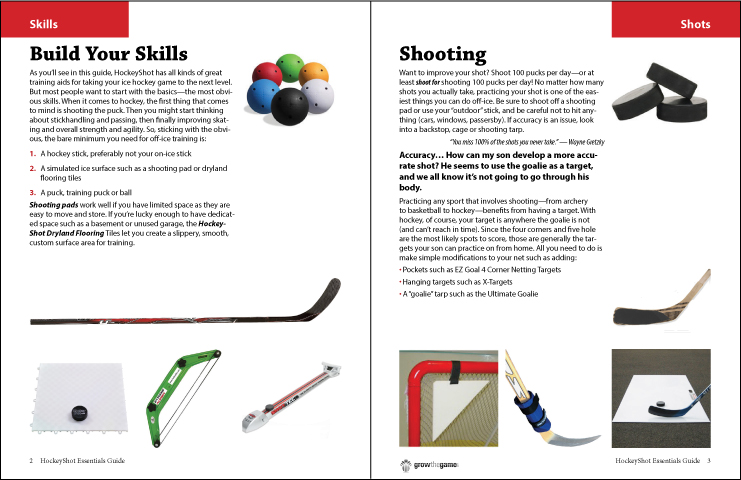
4. Scroll through the document to view other pages. To see the guidelines and placeholder frames on the pages, change the Screen Mode to Normal. Navigate back to pages 2–3, which are the only document pages you’ll lay out in this lesson. You will also lay out a pair of master page spreads.
![]() Note
Note
As you work, feel free to move panels or change the magnification of the document to meet your needs.
5. Close the 03_End.indd file after you have finished examining it, or you can leave this document open for reference.
Creating and saving custom document settings
InDesign lets you save frequently used document settings, including the number of pages, page size, columns, and margins. Choosing one of these saved document parameters, called document presets, when you create a new document saves time and ensures consistency.
1. Choose File > Document Presets > Define.
![]() Tip
Tip
You can use any supported unit of measurement in any dialog box or panel. If you want to use a measurement unit that differs from the default, simply type the indicator for the unit you want to use, such as p for picas, pt for points, and either in or″ (inch marks) for inches, after the value you enter into a box. You can change the default units by choosing Edit > Preferences > Units & Increments (Windows) or InDesign > Preferences > Units & Increments (Mac OS).
2. Click New in the Document Presets dialog box.
3. In the New Document Preset dialog box, set the following:
• In the Document Preset box, type Newsletter.
• In the Number of Pages box, type 8.
• Make sure that the Facing Pages option is selected.
• Use the default Page Size (Letter).
• In the Columns section, type 3 for Number, and leave the gutter at 1p0.
• In the Margins section, make sure that the Make All Settings The Same icon in the center of the margin settings is deselected (![]() ) so that you can enter settings that aren’t the same for all four margins. Type 6p for top; type 4p for the Bottom, Inside, and Outside margins.
) so that you can enter settings that aren’t the same for all four margins. Type 6p for top; type 4p for the Bottom, Inside, and Outside margins.
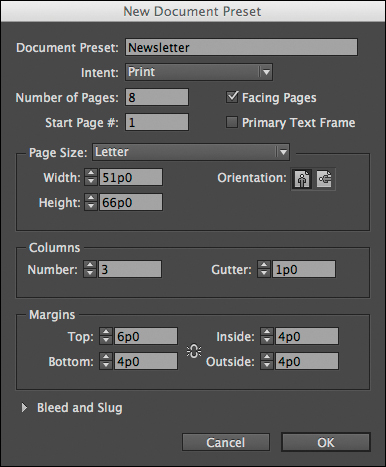
4. Click the small triangle to the left of Bleed And Slug to display additional controls. Type .125 in the Top box of the Bleed option. Then ensure that the Make All Settings The Same icon is selected (unbroken), so that the same value is used for the Bottom, Inside, and Outside boxes. Click inside the Bottom box and notice that InDesign automatically converts measurements expressed using other measurement units (in this case, inches) to the pica and point equivalents.
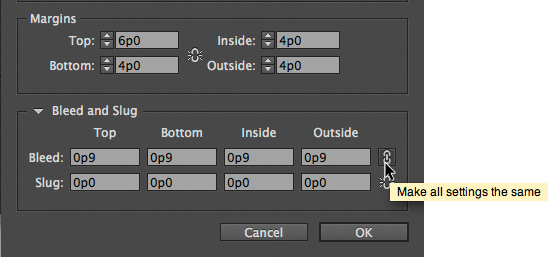
The bleed values specify an area outside the perimeter of each page that can be printed and is used to print design elements, such as pictures or a colored background, that extend to the edge of the page. The bleed area is trimmed and discarded after the printing process.
5. Click OK in both dialog boxes to save the document preset.
![]() Tip
Tip
In the New Document dialog box, the default setting of 1 in the Start Page # box starts the document on a recto (right) page. That is, the first page of the document is to the right of the spine. You can begin a document on a verso page by entering an even value (for example, 2, 4, 8, and so on) in the Start Page # box. The value you enter in this box is assigned to the first page in the document.
Creating a new document
Each time you create a new document, the New Document dialog box lets you choose a document preset as the starting point, or you can use this dialog box to specify several document settings, including the number of pages, the page size, the number of columns, and more. In this section, you’ll use the Newsletter preset that you just created.
1. Choose File > New > Document.
2. In the New Document dialog box, choose the Newsletter preset from the Document Preset menu if it isn’t already selected.
3. Click OK.
InDesign creates a new document using all of the specifications from the document preset, including the page size, margins, columns, and number of pages.
4. Open the Pages panel by clicking its panel icon or choosing Window > Pages. If necessary, drag the lower-right corner of the panel downward until all document page icons are visible.
In the Pages panel, the icon for page 1 is highlighted in gray and the page number below the icon is displayed in reverse to indicate that page 1 is currently displayed in the document window.
The Pages panel is divided into two sections. The top section displays icons for the document’s master pages. A master page is like a background template that you can apply to any of the pages in a document. Master pages contain elements such as headers, footers, and page numbers that appear on all document pages. The lower section of the pages panel displays icons for document pages.
![]() Tip
Tip
You can also create a new document based on a document preset by choosing File > Document Presets > [Preset_Name]. If you press the Shift key when selecting a preset, the New Document dialog box isn’t displayed.
In this document, the default master page (which is given the default name “A-Master”) consists of a two-page spread of facing pages.
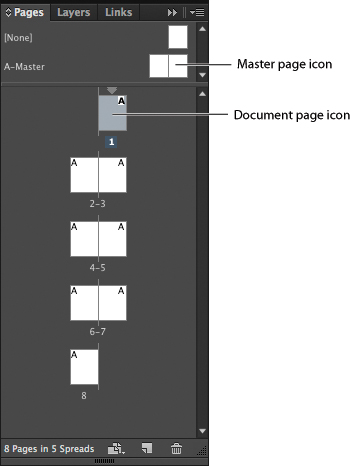
5. Choose File > Save As, name the file 03_Setup.indd, navigate to the Lesson03 folder, and click Save.
Switching between open InDesign documents
As you work, you may want to switch between your new document and the supplied finished document for reference. If both documents are open, you can bring one or the other to the front.

1. Choose the Window menu. A list of currently open InDesign documents is displayed at the bottom.
![]() Tip
Tip
The keyboard shortcut for switching among open InDesign documents is Ctrl+` (Windows) or Command+` (Mac OS). (The ` character is located above the Tab key.)
2. Choose the document you want to view. That document now appears in front.
The names of all open documents are also displayed along the top of the document window starting on the left with the first document opened. Clicking a document’s name displays that document.
Working with master pages
Before you add graphics and text frames to a document, you may want to set up the master pages, which serve as backgrounds for your document pages. Any object that you add to a master page automatically appears on the document pages to which the master page has been applied.
In this document, you’ll create two master page spreads—one containing a grid of guidelines and footer information, and a second containing placeholder frames. By creating multiple master pages, you allow for variation while ensuring consistent design.
Adding guides to the master page
Guides are nonprinting lines that help you lay out a document precisely. Guides placed on a master page appear on any document pages to which that master is applied. For this document, you’ll add a series of guides that, along with the column guides, acts as a grid to help you position graphics frames, text frames, and other objects.
1. In the upper section of the Pages panel, double-click the name A-Master. The master spread’s left and right pages are displayed in the document window.
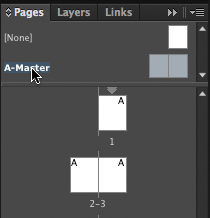
![]() Tip
Tip
If the two pages of the master page spread are not centered in the document window, double-click the Hand tool in the Tools panel to center them.
2. Choose View > Fit Spread In Window to display both pages of the master spread.
3. Choose Layout > Create Guides.
4. Select Preview to display your changes as you make them.
5. For the Rows option, type 4 in the Number box and 0 in the Gutter box.
6. For the Columns option, type 2 in the Number box and 0 in the Gutter box.
7. For Fit Guides To, select Margins and notice how the horizontal guides appear on your master pages.
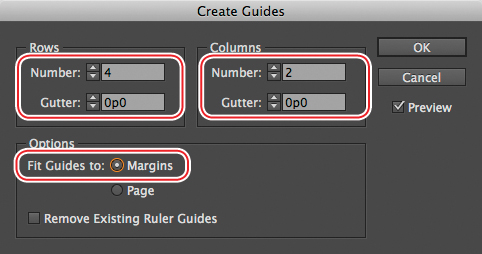
Selecting Margins instead of Page causes the guides to fit within the margin boundaries rather than the page boundaries. You won’t add column guides because column lines already appear in your document.
![]() Tip
Tip
Guides can also be added to individual document pages by using the Create Guides command (Layout menu) when working on a document page rather than a master page.
8. Click OK.
Dragging guides from rulers
You can drag guides from the horizontal (top) and vertical (left side) rulers to provide additional alignment assistance on individual pages. Pressing Ctrl (Windows) or Command (Mac OS) while dragging a guide applies the guide to the entire spread. Pressing Alt (Windows) or Option (Mac OS) while dragging a horizontal guide changes it to a vertical guide and changes a vertical guide to a horizontal guide.
In this lesson, you will place headers above the top margin of the page and footers below the bottom margin in areas where there are no column guides. To position the headers and footers accurately, you will manually add two horizontal guides and two vertical guides.
1. If it’s not already selected, double-click the name A-Master in the Pages panel. If the A-Master spread is not visible in the top section of the Pages panel, you may need to scroll within the top section of the panel to view it. If you want, you can drag the horizontal divider bar between the master page icons and document page icons downward to view the master page icons without having to scroll.
![]() Tip
Tip
You can also drag a ruler guide without the Ctrl or Command key and release the guide over the pasteboard to have a guide appear across all pages in a spread as well as on the pasteboard.
2. Open the Transform panel (Window > Object & Layout > Transform). Without clicking in your document, move the pointer around the document window and watch the horizontal and vertical rulers as the pointer moves. Notice how the hairline indicators in the rulers correspond to the pointer’s position. Also notice that the dimmed X and Y values in the Control panel and the Transform panel indicate the position of the pointer.
![]() Note
Note
The controls in the Transform panel are similar to those in the Control panel. You can use either panel to make many common modifications, such as changing position, size, scale, and angle of rotation.
3. Press Ctrl (Windows) or Command (Mac OS) and position your pointer in the horizontal ruler above the spread. Drag a ruler guide down to 2p6 picas. The Y value is displayed next to the pointer while you drag and is also displayed in the Y box in the Control panel and the Transform panel. Pressing Ctrl (Windows) or Command (Mac OS) when you create a guide causes the guide to extend across both pages of the spread, as well as the pasteboard on either side. If you don’t press Ctrl (Windows) or Command (Mac OS), the guide will extend only across the page on which you release the mouse button.

4. Press Ctrl (Windows) or Command (Mac OS) and drag two more ruler guides from the horizontal ruler: one to 5p and the other to 63p.
5. Press Ctrl (Windows) or Command (Mac OS) and drag a ruler guide from the vertical ruler to the 17p8 position. Watch the X value in the Control panel as you drag. The guide snaps to the column guide at that location. If the X value doesn’t display 17p8 as you drag, place the guide as close as you can, and then—with the guide still selected—highlight the X value in the Control panel or Transform panel, enter 17p8, and then press Enter or Return.
6. Press Ctrl (Windows) or Command (Mac OS) and drag another guide from the vertical ruler to the 84p4 position.
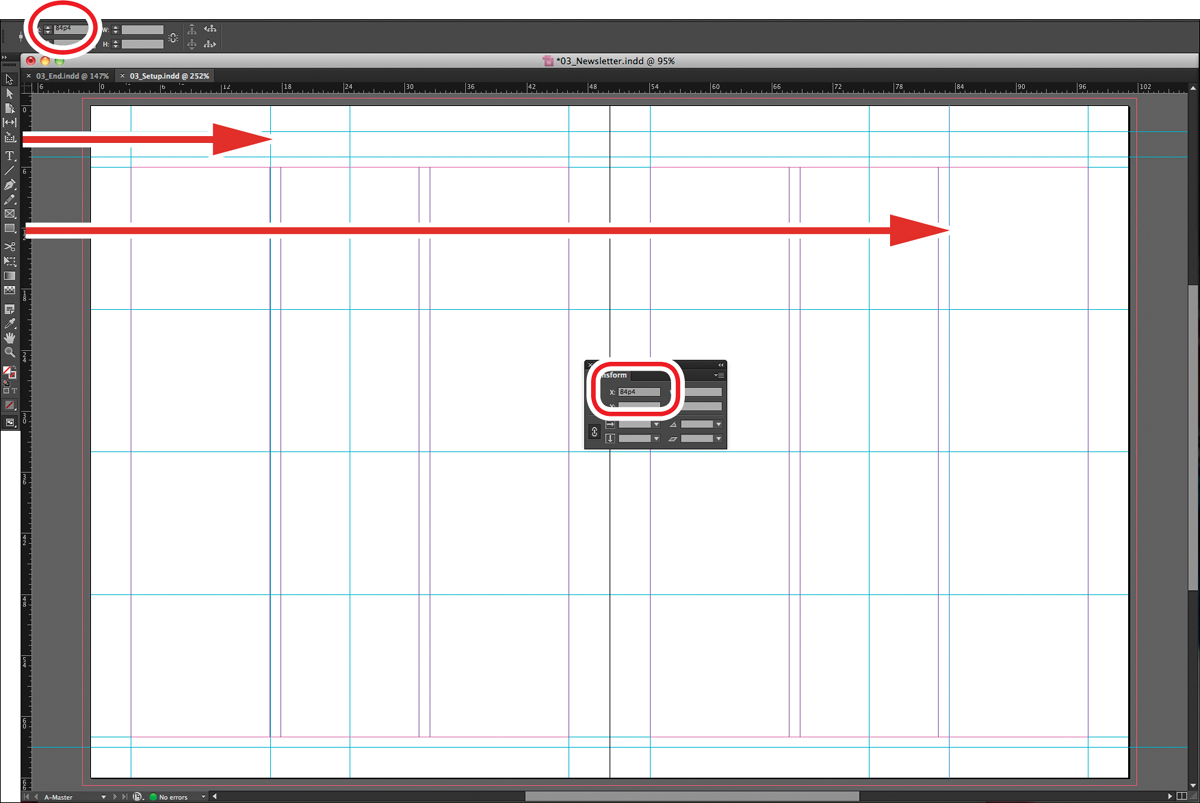
7. Close or dock the Transform panel, and then choose File > Save.
Creating a text frame on the master page
Any text or graphic that you place on a master page appears on pages to which the master is applied. To create a footer, you’ll add a publication title (“HockeyShot Essentials Guide”) and a page number marker to the bottom of the verso (left) and recto (right) components of the document’s facing-page master spread.
1. Make sure that you can see the bottom of the left master page. If necessary, zoom in and use the scroll bars or Hand tool (![]() ).
).
![]() Note
Note
When you draw a frame with the Type tool, the frame starts at the point of the black arrowhead that’s displayed in the upper-left corner of the I-beam pointer. The arrowhead turns white when it’s over a guideline.
2. Select the Type tool (![]() ) in the Tools panel. On the left master page, click where the two ruler guides intersect below the leftmost column and drag to create a text frame, as shown below. The right edge of the text frame should align with the vertical ruler guide in the middle of the page; the bottom edge should align with the bottom of the page.
) in the Tools panel. On the left master page, click where the two ruler guides intersect below the leftmost column and drag to create a text frame, as shown below. The right edge of the text frame should align with the vertical ruler guide in the middle of the page; the bottom edge should align with the bottom of the page.

3. With the insertion point in the new text frame, choose Type > Insert Special Character > Markers > Current Page Number.
The letter A appears in your text frame. On document pages that are based on this master page, the correct page number is displayed, such as “2” on document page 2.
4. To add an em space after the page number, right-click (Windows) or Control-click (Mac OS) with the insertion point in the text frame to display a context menu, and then choose Insert White Space > Em Space. Or you can choose this same command from the Type menu.
5. Type HockeyShot Essentials Guide after the em space.

6. Click a blank area of your document window or choose Edit > Deselect All to deselect the text frame.
Next, you’ll duplicate the footer on the left master page, position the copy on the right master page, and adjust the text so that it’s a mirror opposite of the other footer.
7. Choose View > Fit Spread In Window so that you can see the bottom of both master pages.
8. Using the Selection tool (![]() ), select the footer text frame on the left master page. Hold down the Alt key (Windows) or Option key (Mac OS), and drag the text frame to the right master page so that it snaps to the guides, mirroring the left master page as shown below.
), select the footer text frame on the left master page. Hold down the Alt key (Windows) or Option key (Mac OS), and drag the text frame to the right master page so that it snaps to the guides, mirroring the left master page as shown below.

![]() Tip
Tip
If you also press the Shift key while Alt-dragging (Windows) or Option-dragging (Mac OS) a text frame, movement is constrained to 45-degree angles.
9. Select the Type tool (![]() ), and click anywhere inside the text frame on the right master page, creating an insertion point.
), and click anywhere inside the text frame on the right master page, creating an insertion point.
10. Click Paragraph Formatting Controls (![]() ) in the Control panel, and then click the Align Right button.
) in the Control panel, and then click the Align Right button.

Click Paragraph Formatting Controls at the left side of the Control panel to see the alignment options.
![]() Tip
Tip
Depending on the size of your monitor, the paragraph formatting controls in the Control panel may be visible (to the right of the character formatting controls) without having to click the Paragraph Formatting Controls button.
The text is now right-aligned within the footer frame on the right master page. Now you’ll modify the footer text on the right master page, placing the page number on the right side of the words “HockeyShot Essentials Guide.”
11. Delete the em space and page number at the beginning of the footer.
12. Place the insertion point at the end of “HockeyShot Essentials Guide” and then choose Type > Insert White Space > Em Space.
13. Choose Type > Insert Special Character > Markers > Current Page Number to insert the Current Page Number character after the em space.

Left footer and right footer
14. Choose Edit > Deselect All, and then choose File > Save.
Renaming the master page
When documents contain several master pages, you may want to assign a descriptive name to each master page to make them all easier to identify. You will rename this first master page “3-column Layout.”
1. Choose Window > Pages if the Pages panel is not open. Confirm that the A-Master page is still selected. Choose Master Options For “A-Master” from the Pages panel menu (![]() ).
).
![]() Tip
Tip
In addition to changing the names of master pages, you can use the Master Options dialog box to change other properties of a document’s master pages, such as the prefix, number of pages in the master page spread, and whether a master page is based on another master.
2. In the Name box, type 3-column Layout, and click OK.
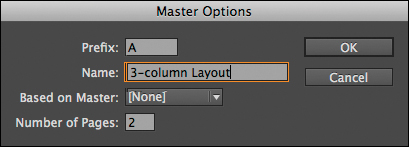
Adding placeholder frames for text
Each page in the body of the newsletter will contain text and graphics. The main text frame and graphics frame are the same on each page, so you’ll create a placeholder text frame and a placeholder graphics frame on the left and right pages of the A-3-column Layout master page.
![]() Tip
Tip
If you’d like to set up a master page spread with different margin and column settings for the left and right pages, you can double-click the individual page in the master page spread, and then change the selected page’s settings by choosing Layout > Margins And Columns.
1. To center the left page in the document window, double-click the left page icon of the A-3-column Layout master in the Pages panel.
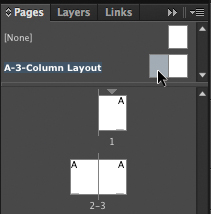
2. Select the Type tool (![]() ). Click where the horizontal and vertical margin guides intersect in the upper-left corner of the page, and drag to create a text frame that extends horizontally across two columns and vertically from the top margin to the bottom margin.
). Click where the horizontal and vertical margin guides intersect in the upper-left corner of the page, and drag to create a text frame that extends horizontally across two columns and vertically from the top margin to the bottom margin.
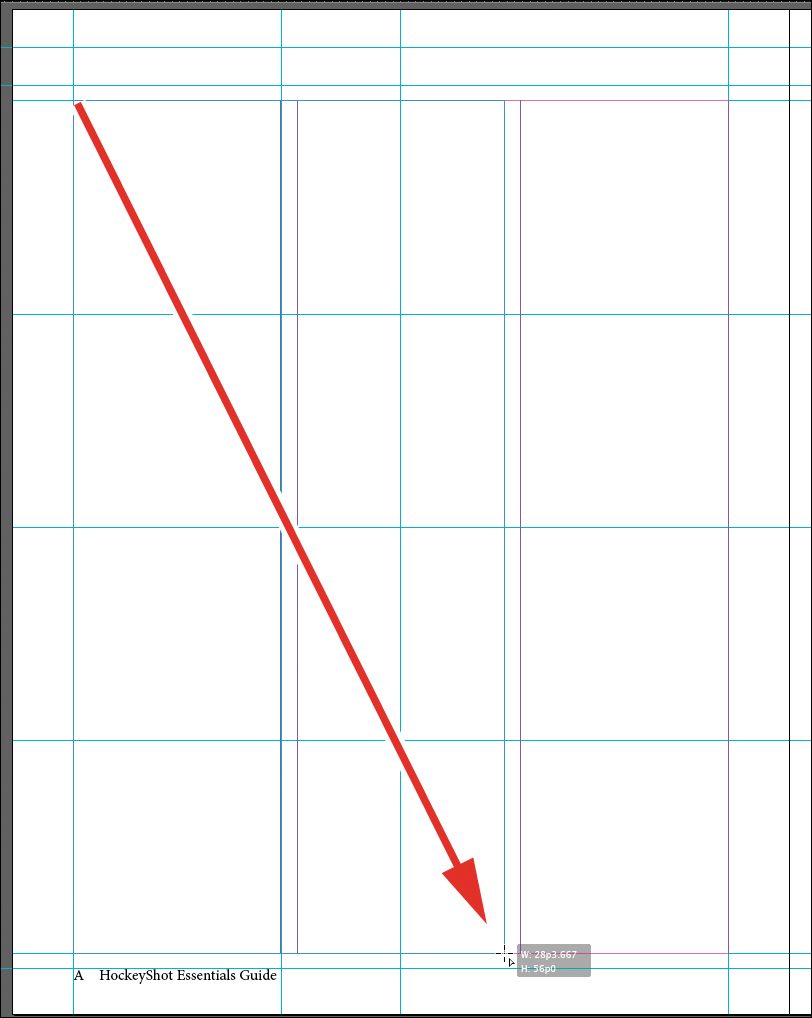
3. Double-click the right page icon of the A-3-column Layout master in the Pages panel to center it in the document window.
4. With the Type tool (![]() ), create another text frame on the right page that’s identical to the text frame you just created on the left page. Make sure the upper-left corner of the frame aligns with the intersection of the margin guides in the upper-left corner of the page.
), create another text frame on the right page that’s identical to the text frame you just created on the left page. Make sure the upper-left corner of the frame aligns with the intersection of the margin guides in the upper-left corner of the page.
5. Click a blank area of the page or pasteboard, or choose Edit > Deselect All.
6. Choose File > Save.
Adding placeholder frames for graphics
You have now created placeholder text frames for the main text on each page. Next, you’ll add two graphics frames to the A-3-column Layout master. Similar to the text frames you created, these frames act as placeholders on document pages, helping you to maintain a consistent design.
![]() Note
Note
It’s not necessary to add placeholder frames to every document you create. For example, one-page documents, such as business cards and ads, don’t require master pages and placeholder frames.
Although the Rectangle tool (![]() ) and the Rectangle Frame tool (
) and the Rectangle Frame tool (![]() ) are more or less interchangeable, the Rectangle Frame tool, which includes a nonprinting X, is commonly used to create placeholders for graphics.
) are more or less interchangeable, the Rectangle Frame tool, which includes a nonprinting X, is commonly used to create placeholders for graphics.
1. Select the Rectangle Frame tool (![]() ) in the Tools panel.
) in the Tools panel.
2. Position the crosshair pointer at the intersection of the top margin guide and the right margin guide on the right page.
Drag down and to the left to create a frame that extends one column width horizontally and vertically to the next ruler guide.

3. Create an identical placeholder graphics frame on the left page.
4. Use the Selection Tool to click a blank area of the page or pasteboard, or choose Edit > Deselect All.
5. Choose File > Save.
Creating an additional master page
You can create multiple master pages within a document. You can build them independently or base one master page on another master page. If you base a master page on another master, any change made to the parent master is automatically applied to the child master.
For instance, the A-3-column Layout master page is useful for most of the pages in the newsletter and can be used as the basis for another set of master pages that share key layout elements, such as margins and the current page number character.
To accommodate different layouts, you will create a separate master page spread that uses a two-column format, and then you’ll modify the two-column layout.
1. In the Pages panel, choose New Master from the Pages panel menu.
2. In the Name box, type 2-column Layout.
3. From the Based On Master menu, choose A-3-column Layout, and click OK.
Notice that the letter A is displayed on the B-2-column Layout master page icons at the top of the Pages panel. This letter indicates that the A-3-column Layout master serves as the foundation for the B-2-column Layout master. If you were to change the A-3-column Layout master, the changes would also be reflected in the B-2-column Layout master. You may also notice that you cannot easily select objects, such as the footers, from other master pages. You’ll learn about selecting and overriding master page items later in this lesson.
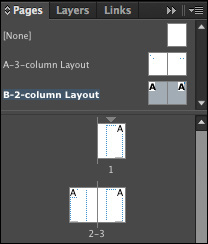
![]() Tip
Tip
If all of the master page icons are not visible in the Pages panel, click the horizontal bar that separates the master page icons from document page icons and drag down until the other master page icons are visible.
4. Choose Layout > Margins And Columns.
5. In the Margins And Columns dialog box, set the number of columns to 2, and then click OK.
Overriding master items
The document pages that will use the two-column layout do not require placeholder frames, which means that only the footer text frames and the ruler guides from the A-3-column Layout master are required. Next, you’ll remove the placeholder frames from the B-2-column Layout master.
1. Using the Selection tool (![]() ), click within the graphics frame on the left page of the B-2-column Layout master. Nothing happens. Because this frame is inherited from the parent master, you can’t select it with a simple click.
), click within the graphics frame on the left page of the B-2-column Layout master. Nothing happens. Because this frame is inherited from the parent master, you can’t select it with a simple click.
2. Hold down Shift+Ctrl (Windows) or Shift+Command (Mac OS), and then click within the graphics frame. The frame is now selected, and you have overridden its status as a master item. Press Backspace or Delete to delete the frame.
3. Use the same method to delete the placeholder graphics frame on the right page, as well as the placeholder text frame on the left and right pages.
![]() Tip
Tip
To override multiple master page items, hold down Shift+Ctr (Windows) or Shift+Command (Mac OS) and with the Selection Tool, drag a marquee around the objects you want to override.
4. Choose File > Save.
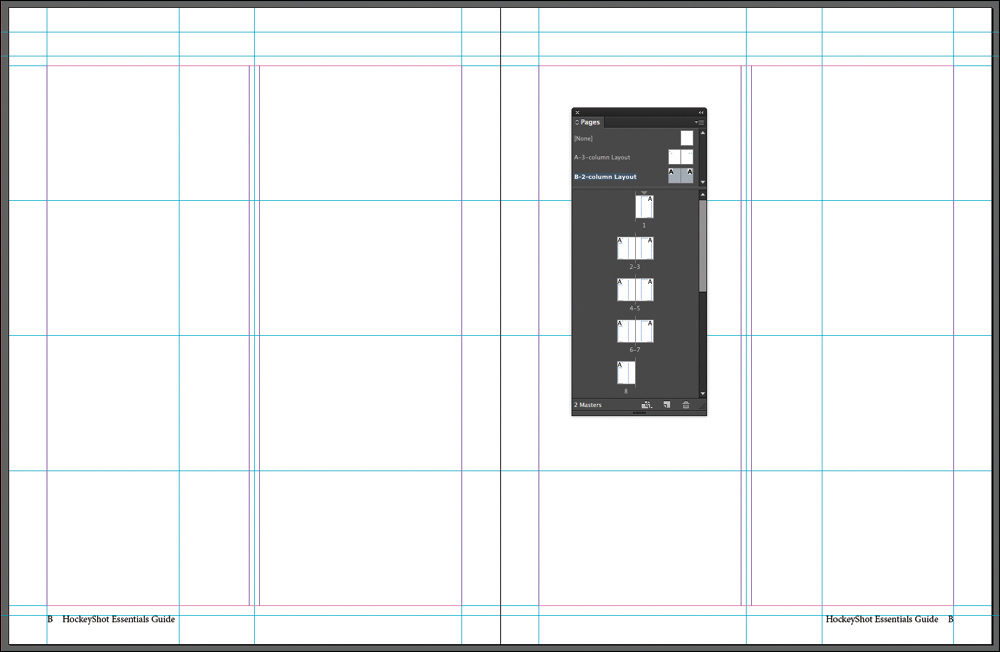
Modifying a parent master
To complete your work laying out the newsletter’s master pages, you’ll add several header elements to the top of the A-3-column Layout master and another footer element to the right page. Then you’ll view the B-2-column Layout master and see how the new objects are automatically added to that spread.
Rather than manually laying out the additional header and footer frames, you’ll import a snippet. Similar to a graphic file, a snippet is a file that contains InDesign objects, including their location relative to one another on a page or spread. InDesign lets you export selected objects as a snippet file and place snippets into documents. (You’ll use snippets again later in this lesson, and you’ll learn more about snippets in Lesson 10, “Importing and Modifying Graphics.”)
![]() Note
Note
You’ll learn more about creating and modifying text frames, graphics frames, and other kinds of objects in Lesson 4, “Working with Objects.”
1. Double-click the name of the A-3-column Layout master in the Pages panel to display the spread.
2. Choose File > Place. Open the Links folder in the Lesson03 folder, located inside the Lessons folder within the InDesign CIB folder. Click the file named Snippet1.idms, and then click Open.
3. Position the loaded snippet icon (![]() ) outside the upper-left corner of the spread, where the red bleed guides meet. Click to place the snippet.
) outside the upper-left corner of the spread, where the red bleed guides meet. Click to place the snippet.
The snippet places a header at the top of each page, as well as an imported graphic at the bottom of the right page. Each header includes an empty red graphics frame and a text frame with white placeholder text.
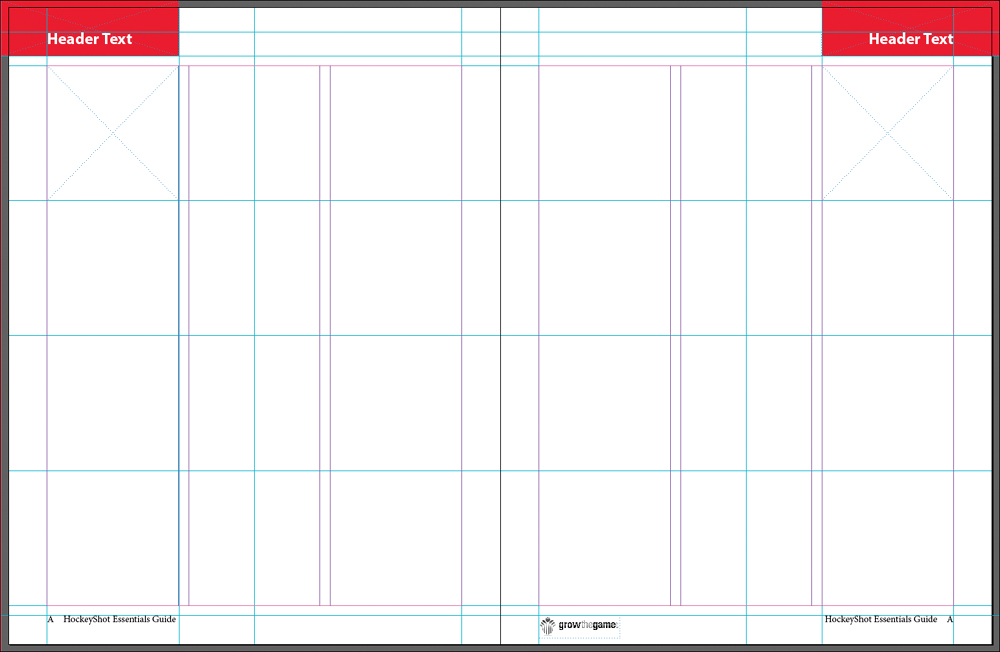
![]() Tip
Tip
To create a snippet, select one or more objects on a page or spread. Choose File > Export, and then choose InDesign Snippet from the Save As Type menu (Windows) or the Format menu (Mac OS). Choose the location of the file, assign a name, and then click Save.
4. Double-click the name of the B-2-column Layout master in the Pages panel. Notice how the new elements you just applied to the A-3-column Layout master have been automatically applied to this child master.
5. Choose File > Save.
Applying master pages to document pages
Now that you have created all of the master pages, it’s time to apply them to the pages in the document. By default, all of the document pages are formatted with the A-3-column Layout master. You will apply the B-2-column Layout master to the several pages in the newsletter, and you’ll apply the None master page to the cover page, which doesn’t require header or footer information and thus does not require a master page.
You can apply master pages to document pages by dragging master page icons onto document page icons or by using an option in the Pages panel menu. In large documents, you may find it easier to display the page icons horizontally in the Pages panel.
1. Double-click the name of the B-2-column Layout master in the Pages panel. Make sure that all master pages and document pages are visible in the panel.
2. Drag the left page icon of the B-2-column Layout master onto the icon of document page 4. When page 4 is displayed with a black border, indicating it’s the page to which the selected master will be applied, release the mouse button.
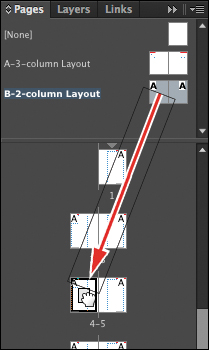
3. Drag the right page icon of the B-2-column Layout master onto the icon of document page 5, and then drag the left page icon onto document page 8.
4. Double-click the page numbers 4–5 (below the page icons) in the Pages panel to display this spread. Notice that the two pages of this spread have the two-column layout of the applied master page, as well as the header and footer elements that you placed on the parent master page. Also notice that the correct page numbers are displayed on each page as a result of the Current Page Number characters you placed on the A-3-column Layout master page spread.
5. Double-click the icon for document page 1. Because it’s based on the A-3-column Layout master, it includes header and footer elements, which aren’t required on the cover of the newsletter.
6. Choose Apply Master To Pages from the Pages panel menu. In the Apply Master dialog box, choose [None] from the Apply Master menu and make sure that 1 is the page number in the To Pages box. Click OK.

7. Choose File > Save.
Adding new document pages
You can add new pages to your existing document. Next, you’re going to add six additional pages to your newsletter. Later in this lesson, you’ll use four of these pages for a “special section” within your newsletter that uses a different page size and separate page numbering.
1. In the Pages panel menu, choose Insert Pages.
2. In the Insert Pages dialog box, type 6 in the Pages box, choose After Page from the Insert menu and enter 4 in the accompanying (page number) box, and then choose [None] from the Master menu.

3. Click OK. Six blank pages are added in the middle of the document. Lengthen the Pages panel so that you can see all document pages.
Rearranging and deleting document pages
You can use the Pages panel to rearrange the sequence of pages and delete extra pages.
1. In the Pages panel, click on page 12 to select it. Notice that it’s based on the A-3-column Layout master. Drag the pointer upward onto the icon for page 11, which is based on the B-2-column Layout master. When the small arrow inside the hand is pointing to the right, indicating that page 11 will be “pushed” in that direction, release the mouse button.
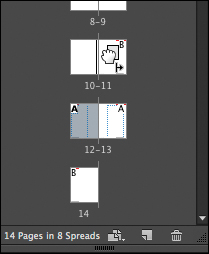
Notice that page 11 is now based on the A-3-column Layout master, and the page that had previously been page 11 is now page 12. Pages 13 and beyond remain unchanged.
2. Click page 5, and then press the Shift key and click page 6 (two of the six pages you inserted earlier) to select this spread.
3. Click the Delete Selected Pages button icon (![]() )at the bottom of the panel. Pages 5 and 6 are deleted from the document.
)at the bottom of the panel. Pages 5 and 6 are deleted from the document.
4. Choose File > Save.
Changing the size of pages
Next, you’ll create an insert within the newsletter by changing the size of the pages in the “special section” you created earlier in the lesson. You’ll then quickly lay out the two spreads that make up this section.
1. Select the Page tool (![]() ). Click page 5 in the Pages panel, and then press the Shift key and click page 8. The icons for pages 5–8 are highlighted in the panel. These are the pages whose size you will change.
). Click page 5 in the Pages panel, and then press the Shift key and click page 8. The icons for pages 5–8 are highlighted in the panel. These are the pages whose size you will change.
2. In the Control panel, enter 36p in the Width box; enter 25p6 in the Height box. Press Enter or Return each time you enter a value to apply it to the selected pages. (These values produce a 6″ × 4.25″ insert—the size of a standard postcard.)
3. Double-click page 4 in the Pages panel, and then choose View > Fit Spread In Window. Notice that the spread now contains pages of unequal size.
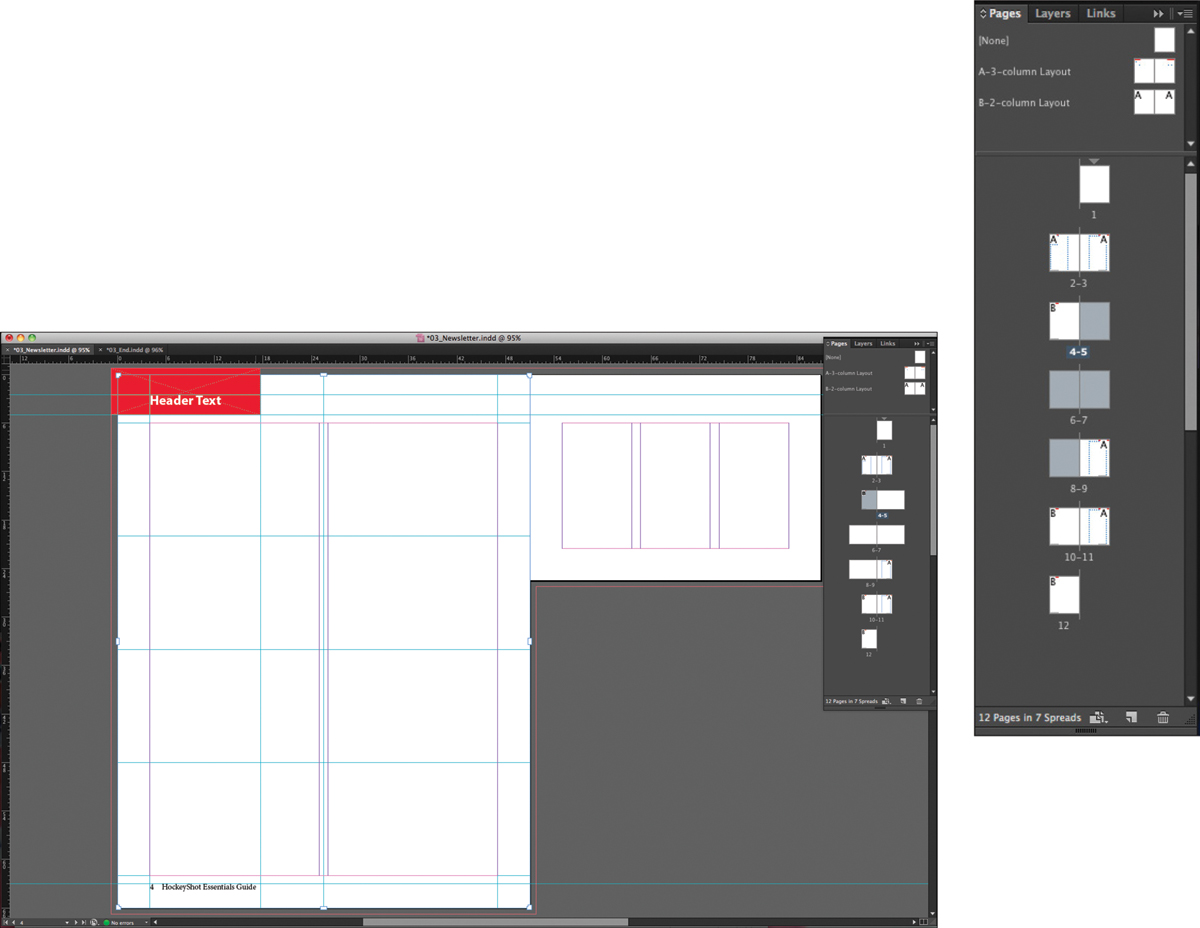
4. Use the Page tool to select pages 5–8.
5. To set new margin and column guides for the selected pages, choose Layout > Margins And Columns to display the Margins And Columns dialog box. In the Margins section, make sure that the Make All Settings The Same icon (![]() ) in the center is selected (unbroken) so that you can enter one setting for all four margins. Enter 1p6 in the Top box. In the Columns section, enter 1 in the Number box, and then click OK.
) in the center is selected (unbroken) so that you can enter one setting for all four margins. Enter 1p6 in the Top box. In the Columns section, enter 1 in the Number box, and then click OK.
Adding sections to change page numbering
The special section you just created will use its own page-numbering system. You can use different kinds of page numbering within a document by creating sections. Next, you’ll start a new section on the first page of the special section, and then you’ll adjust the page numbering of the subsequent newsletter pages so that they’re numbered correctly.
1. In the Pages panel, double-click the page 5 icon to select and display it.
2. Choose Numbering & Section Options from the Pages panel menu. In the New Section dialog box, make sure that Start Section and Start Page Numbering are selected and the Start Page Number At is 1.
3. Choose i, ii, iii, iv from the Style menu in the Page Numbering section of the dialog box. Click OK.

4. Examine the page icons in the Pages panel. Starting with the fifth document page, the numbers below the page icons now appear as Roman numerals. The numbers in the footers of the remaining document pages that contain footers also appear as Roman numerals.
Now you’ll specify for the document to use Arabic numerals for the newsletter pages that follow the special section and to continue the numbering from the page prior to the first page of the special section (Page 4).
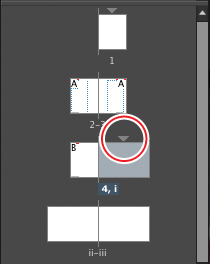
The triangle above the page i icon indicates the start of a section.
5. Select page v in the Pages panel by clicking once.
![]() Note
Note
Single-clicking a page icon targets the page for editing purposes but does not cause that page to be displayed in the document window. If you want to navigate to a page, double-click its icon in the Pages panel.
6. Choose Numbering & Section Options from the Pages panel menu.
7. In the New Section dialog box, make sure that Start Section is selected.
8. Select Start Page Numbering At and specify a value of 5 in the accompanying box to start section numbering on page 5 and resume the numbering of the document pages (1–4) that precede the special section.
9. Make sure that 1, 2, 3, 4 is selected in the Style menu, and then click OK.
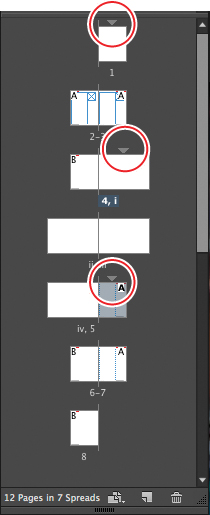
Now your pages are correctly renumbered. Notice that a black triangle appears above pages 1, i, and 5 in the Pages panel, indicating the start of a new section.
10. Choose File > Save.
Overriding master page items on document pages and placing text and graphics
Now that the framework of the 12-page publication (the eight-page guide and four-page insert) is in place, you’re ready to lay out document pages. To see how the work you’ve done setting up the document’s master pages affects the document pages, you’ll add text and graphics to the spread on pages 2 and 3. You’ll learn more about creating and modifying objects in Lesson 4, “Working with Objects,” so for this lesson, we’ve simplified the layout process to minimize your work.
1. Choose File > Save As, name the file 03_Newsletter.indd, navigate to the Lesson03 folder, and click Save.
2. In the Pages panel, double-click the page 2 icon (not page ii), and then choose View > Fit Spread In Window.
Notice that since the A-3-column Layout master is assigned to pages 2 and 3, the page includes the guides, the headers and footers, and the placeholder frames from the A-3-column Layout master.
To import text and graphics from other applications, such as images from Adobe Photoshop or text from Microsoft Word, you’ll use the Place command.
3. Choose File > Place. If necessary, open the Links folder in the Lesson03 folder, located inside the Lessons folder within the InDesign CIB folder. Click the Article1.docx file, and then Shift-click the Graphic2.jpg file. Four files are selected: Article1.docx, Article2.docx, Graphic1.jpg, and Graphic2.jpg. Click Open.
The pointer changes to a loaded text icon (![]() ), with a preview of the first few lines of the Article1.docx text file that you are placing.
), with a preview of the first few lines of the Article1.docx text file that you are placing.
![]() Tip
Tip
Parentheses are displayed when InDesign recognizes a preexisting frame beneath the loaded text icon or the loaded graphics icon when importing text or graphics into a layout. If you click within an existing frame, InDesign uses that frame rather than create a new text or graphics frame.
4. Position the loaded text icon over the placeholder text frame on page 2, and then click to place the Article1.docx text into the frame.
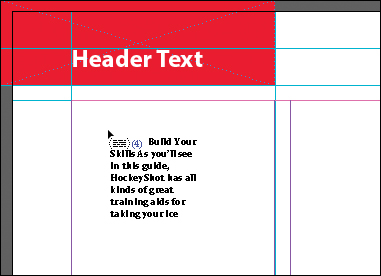
5. To place the three remaining files, click within the text frame on page 3 to place the Article2.docx text, click within the graphics frame on page 2 to place Graphic1.jpg, and click within the graphics frame on page 3 to place Graphic2.jpg.
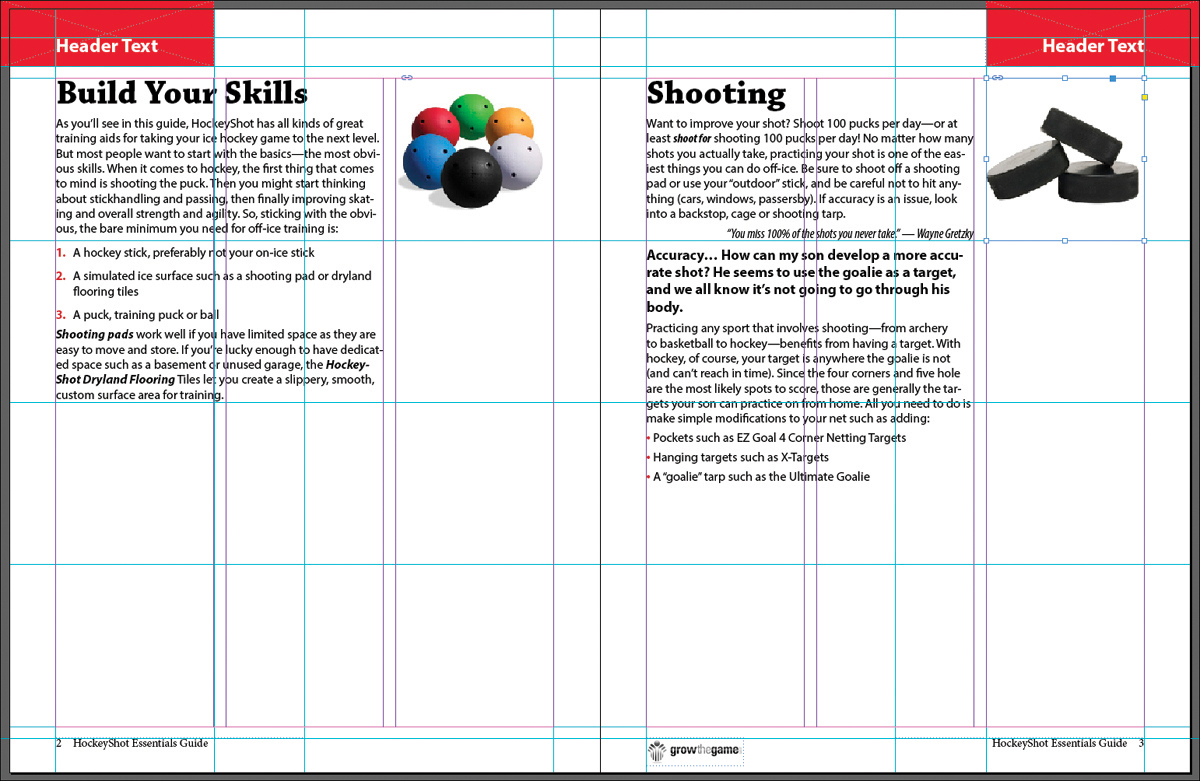
6. Choose Edit > Deselect All.
You’ll import a snippet to complete the layout of the spread.
7. Choose File > Place. Click the Snippet2.idms file, and then click Open.
8. Position the loaded snippet icon (![]() ) outside the upper-left corner of the spread where the red bleed guides meet. Click to place the snippet.
) outside the upper-left corner of the spread where the red bleed guides meet. Click to place the snippet.
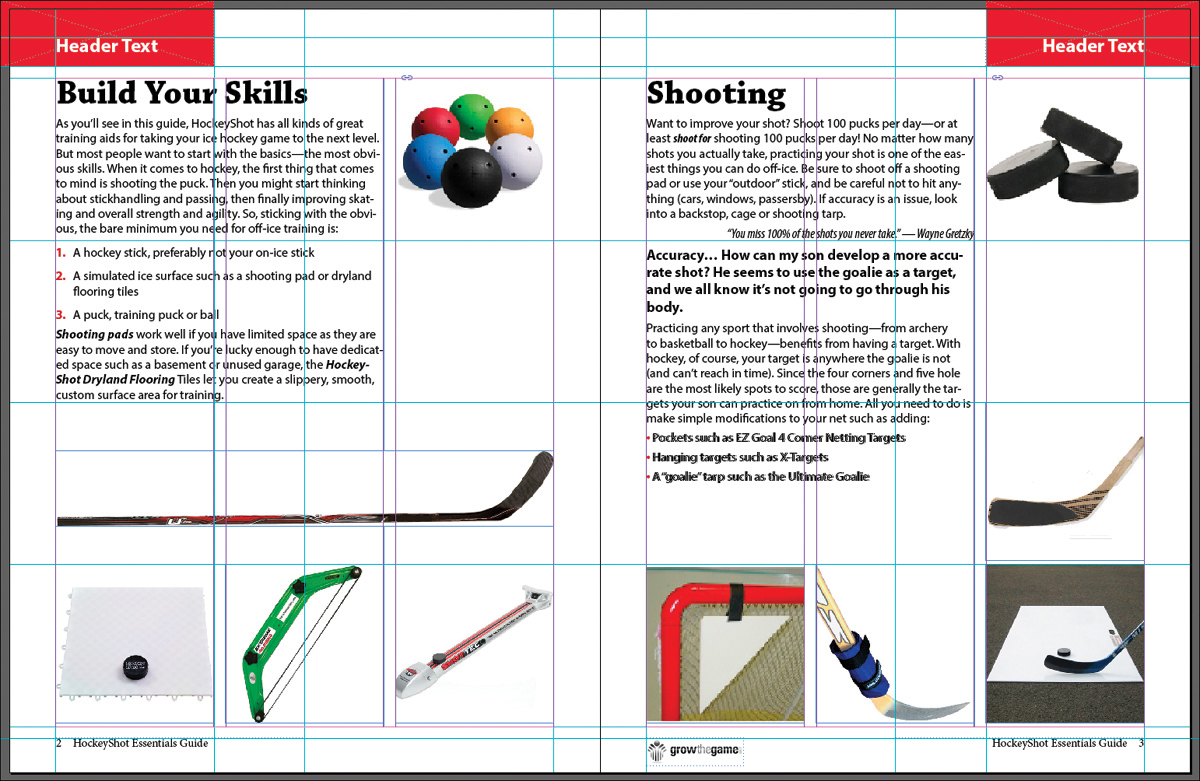
9. Choose Edit > Deselect all, or click an empty area of the page or pasteboard to deselect all objects.
10. Choose File > Save.
Next, you’ll override two master items on your spread—the text frames that contain the header text—and then replace the placeholder text with new text.
1. Select the Type tool (![]() ). Hold down Shift+Ctrl (Windows) or Shift+Command (Mac OS), and then click within the placeholder text frame on page 2 that contains “Header Text.” Replace the placeholder text with Skills.
). Hold down Shift+Ctrl (Windows) or Shift+Command (Mac OS), and then click within the placeholder text frame on page 2 that contains “Header Text.” Replace the placeholder text with Skills.
2. Repeat step 1 to change the header text on page 3 to Shots.
3. Choose File > Save.
Viewing the completed spread
At this point you’re ready to hide guides and frames and see what the completed spread looks like.
1. Select the Selection tool (![]() ), and double-click the page 2 icon in the Pages panel to display it.
), and double-click the page 2 icon in the Pages panel to display it.
2. Choose View > Fit Spread In Window and hide any panels, if necessary.
3. Choose View > Screen Mode > Preview to hide the pasteboard and all guides, grids, and frame edges.
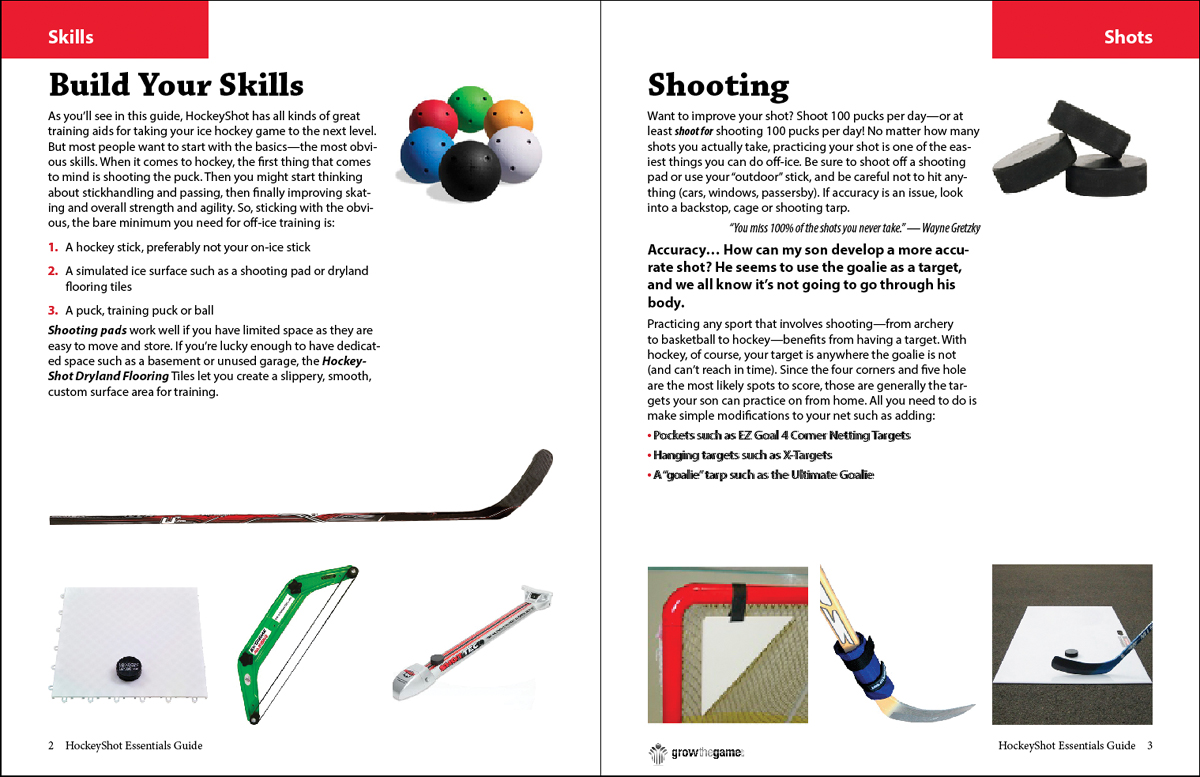
![]() Tip
Tip
To alternately hide and show all panels, including the Tools panel and Control panel, press Tab. (You can’t do this when you’re working with text using the Type tool.)
You have formatted enough of the 12-page document to see how adding objects to the master pages helps you maintain a consistent design throughout your document.
4. Choose File > Save.
Congratulations. You have finished the lesson.
Exploring on your own
A good way to reinforce the skills you’ve learned in this lesson is to experiment with them. Try some of the following exercises. They’ll give you more practice with InDesign techniques.
![]() Tip
Tip
Choose View > Screen Mode > Normal to return to normal display as you explore on your own.
1. Place another photograph in the third column on page 3. Use the GraphicExtra.jpg image that is inside the Links folder in the Lesson03 folder. After you click Open in the Place dialog box, click where the horizontal ruler guide intersects with the left margin of the third column, drag until the frame is as wide as the column, and then release the mouse button.
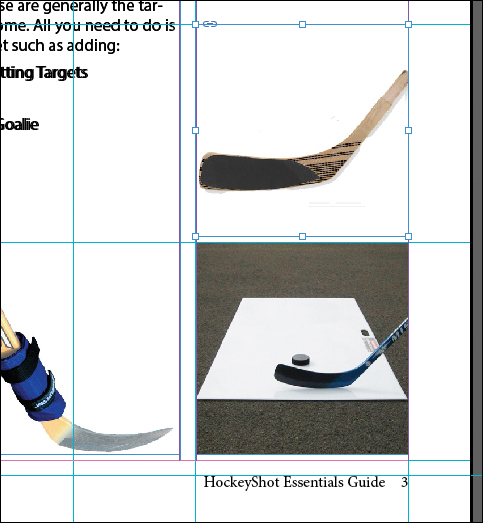
2. Create another master page for the document. Base it on the A-3-column Layout master, name it C-4-column Layout, and then modify it so that it contains four columns instead of three. Apply the new master page to any of the pages that don’t contain objects.
Review questions
1. What are the advantages of adding objects to master pages?
2. How do you change the page-numbering scheme within a document?
3. How do you select a master page item on a document page?
4. What’s the advantage of basing a new master page on an existing master page?
Review answers
1. By adding objects such as guides, footers, and placeholder frames to master pages, you can maintain a consistent layout on the pages to which the master is applied.
2. In the Pages panel, select the page icon where you want new page numbering to begin. Then, choose Numbering & Section Options from the Pages panel menu and specify the new page-numbering scheme.
3. Hold down Shift+Ctrl (Windows) or Shift+Command (Mac OS), and then click the object to select it. You can then edit, delete, or manipulate the object.
4. By basing a new master page on an existing master page you create a parent-child relationship between the new master and the existing one. Any changes you make to the parent master page are automatically applied to the child master.

